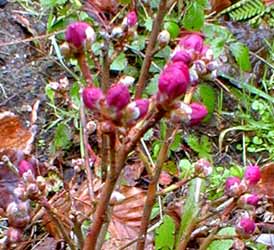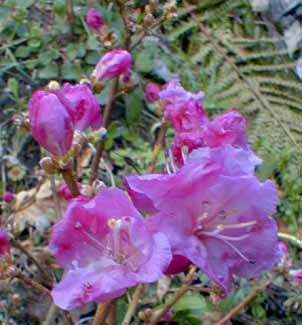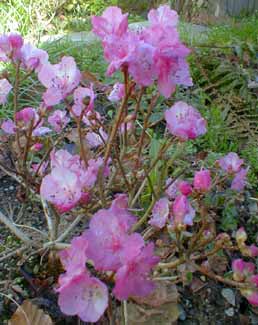
'Crater's Edge'
Korean Snow Azalea
"My garden of flowers is also my garden of thoughts and dreams."
-Abram Linwood Urban,
1913
1913
Rhododendron mucronulatum is called the Snow Azalea because it frequently blooms at winter's end while snow is still upon the ground.
On Puget Sound, if it is in a sunny spot & a winter days are unseasonably warm, this shrub can be fooled into assuming spring is just around the corner, & bloom as early as December, though if it does so, it will be at risk of frosty mornings shortening the life of the blooms.
In a protected shady spot it will hold back its blooms, but even so its bright rose-red buds will be starting to showing hints of color mid to late January. The bud-photo at top of the page is from the last week in February.
 The second photo is from early March when starting on the sun-facing side of the shrub it began opening its buds to gorgeous pink flowers. The third shot later in March. In colder zones it may wait until April to bloom, but in most gardens it will be one of the very earliest if not the very first azalea to burst forth with color.
The second photo is from early March when starting on the sun-facing side of the shrub it began opening its buds to gorgeous pink flowers. The third shot later in March. In colder zones it may wait until April to bloom, but in most gardens it will be one of the very earliest if not the very first azalea to burst forth with color.The wide-ranging species is native to Siberia, Mongolia, China, Korea & Japan, growing four to eight feet tall, with upright & rounded habit. Because of its wide range, it has many variant forms & varied flower colors. The cloned 'Crater's Edge' is a smaller semi-dwarf form with a ten-year height of only three feet. The variant was found at high elevations on Cheju Island, Korea, carried down by Warren Berg.
Warren Berg lives in Port Ludlow not awfully far from the abode of Paghat & Granny Artemis. He is something of a super-hero both to local & international rhodophiles, for his expeditions of plant discovery, & for his hybridizations. It is hardly any surprise that he holds a Gold Medal Award from the American Rhododendron Society, given in honor of service & achievement in the world of rhododendrons.
 In Asia, this species grows wild on rocky dryish slopes at elevations of 1,000 to 5,500 feet. In the garden it wants full sun either morning or afternoon, or partial shade, & extremely well-draining moist rich soil.
In Asia, this species grows wild on rocky dryish slopes at elevations of 1,000 to 5,500 feet. In the garden it wants full sun either morning or afternoon, or partial shade, & extremely well-draining moist rich soil.Despite its fondness for sun, it does not like heat, so if there are larger deciduous shrubs or trees around it, that would help shelter it against summer stress, while yet leaving the area open to light early & late in the year.
The species name alludes to the small point on the little leaves, which are fragrant if brushed into or bruised. Although it has somewhat the appearance of an evergreen azalea such as among the Kurume group, it is a fully deciduous species shrub.
In autumn the foliage ranges from moderately to very attractive, at the very least turning shades of yellow & magenta, & during some autumns, imposingly scarlet. Leaf portraits can be viewed on the 'Crater's Edge' page of the Azaleas & Rhodies autumn leaves garden walk. Come winter, it has a twiggy attractiveness, the limbs dotted with yellow resin.
It blooms so early that no leaves will have as yet returned, but it will have some of its leaves before it is finished flowering. The dark buds open into lighter flowers that have an appearance of tissue-vellum, mottled white & rose-violet of two shades, rather cloudy in pattern, plus big stamins. A unique & appealing little shrub on every score.